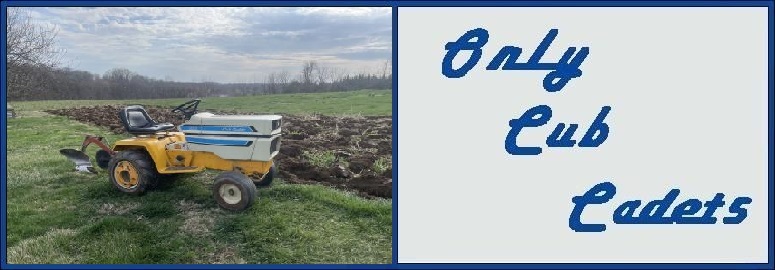
 |
Another Weight Bracket
2 Attachment(s)
Here's a weight bracket I made for my 1912. It'll hold 200 lbs. to offset my 451 snowblower (modified for a 4 1/2" PTO). I'll probably leave 100 lbs. on it for mowing as I noticed a little wheel spin when mowing with no weight using my 60" deck.
Made from 1/4" plate and a 1" x 8" grade-8 bolt. It's bolted to the frame through existing holes with four 3/8" and two 7/16" bolts. Now if you have to go out and buy the weight plates new, this won't really save you any money over some generic 70 lb. wheel weights (about $1/lb.), but I use the same plates on a cat. 0 weight bar I made for my ingersoll 6018 loader tractor. Plus this way I don't have to scratch up my newly painted wheels and the leverage around the axle is an added benefit with the snowblower. |
Nice work on the weight bracket delikocc :ThumbsUp:
|
Maybe drill a hole in the threaded end to add an "R" clip after the Nut is on.
For sure the nut will loosen .. the Nut will be lost and picking up 50 lb weights with Mittens on just doesn't work. |
That bolt likely cost as much as the steel in the rest of the bracket.
Looks good. |
Nice work on the weight bracket!
|
Quote:
Wheel weights are actually better for the axle bearings since the actual weight is supported by the wheels themselves, not hanging off the back adding additional load on the bearings themselves. I had probably 250 lbs hanging off the back of my 125 when I used my QA42. When I changed to loaded tires and wheel weights, I seem to have better traction too. I had this bracket http://img.photobucket.com/albums/v7..._DCP_1604A.jpg with these plates ( 5 total ) http://img.photobucket.com/albums/v7..._DCP_1605A.jpg and did better with loaded tires and wheel weights ( with chains) http://img.photobucket.com/albums/v7...h_DCP_5799.jpg http://img.photobucket.com/albums/v7...DCP_5800-1.jpg click all pics for larger view |
looks like it should be there.
nice work. |
Almost every time there is a thread about adding weight to the rear of a Cub Cadet tractor, the issue of inducing abnormal wear to the rear axle bearings invariably comes up; especially when adding weight to the actual tractor as opposed to the wheels. I don't know if anyone has ever analyzed the axle bearing loading in previous threads, but I will delve into it a little here to hopefully quell some of the misconceptions.
The needle bearings used in the Cub Cadet rear axle have so much excess load capacity that the risk of the bearings (or inner race/axle) suffering abnormal wear from a couple of hundred pounds of added weight is nonexistant. From the SKF (bearing manufacturer) website, "In spite of their low cross section, needle roller bearings have a high load carrying capacity." The rear axle bearings are 1 in. I.D. by about 3/4 in. height. (I am guessing at the height from pictures, so if it is less, then the load capacity is a little less than what follows, but there is so much excess capacity that it doesn't really matter.) From the SKF catalog, the load capacity of a standard 1 in. x 3/4 in. drawn cup needle bearing is 4,271 lbf dynamic and 7,306 lbf static. (Note that this is with an 11,000 RPM limiting speed.) This is for standard, off-the-shelf, throw-away, needle bearings. A Cub Cadet 982 is about 875 lbs (some of that would be rolling weight, so the force on the bearings is actually less; but we won't worry about that here), plus the operator at about 200 lbs (OK maybe 230:)), for a total weight of about 1,100 lbs. Assuming a weight distribution of about 70/30 (rear/front), that would equal a static force on each bearing of about 385 lbs. (Just guessing on the weight distribution; but again, there is so much excess capacity that if some of the basis for my calculations is off by a little it doesn't really matter to the point I am trying to make.) Now there are going to be some higher momentary forces applied to each bearing as you're bouncing down the driveway snowblowing at 3 mph (man I love that 451 blower), but even with that considered, adding 200 pounds (only 100 lbs. per rear axle bearing or less depending on where you put it), or so, of non-rolling weight to the tractor is not going to even come close to loading the axle bearings to their dynamic capacity of almost 4,300 lbs. each. There are various pros and cons to consider when adding weight to either the wheels or off the back of the tractor, but the one thing that I would not worry about in making that decision is overloading the rear axle bearings. It is not a factor. (Now about overloading that MTD aluminum rearend...; I think I'll look into Xtreme Motorworks rear axle reinforcement brace before it actually breaks.) |
| All times are GMT -4. The time now is 02:19 AM. |
Powered by vBulletin® Version 3.8.11
Copyright ©2000 - 2025, vBulletin Solutions Inc.